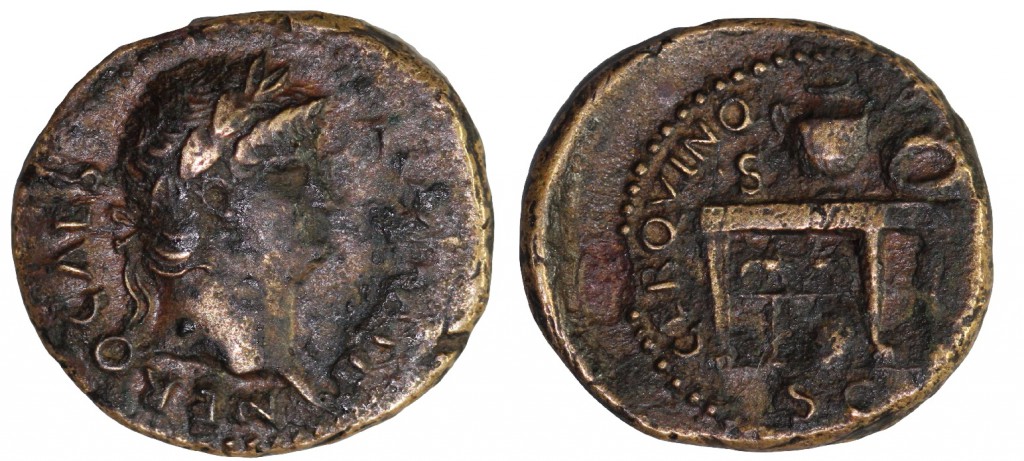July 18, 2015, by Will Leveritt
Tonight in AD64 the Great Fire of Rome started
Text by Annabel Rock-Clarke
Image © Mint Imperials
On the night of the 18th July, AD 64, in the reign of the emperor Nero, the Great Fire of Rome broke out. It raged for six days and seven nights destroying more than half of the city; many citizens were killed and many survivors lost everything. Cramped streets and alleys, and the extensive use of wood as a building material, helped the inferno to spread across the city. Of the 14 city districts, only 4 remained untouched by the blaze.

AE semis of Nero. Obverse has laureate head r., NERO CAES AVG IMP. Reverse has table with urn and shield, S denomination mark, CER QUINQ ROM CO, SC in ex. 2.81g, 18mm, 6 o’clock.
There are several ancient accounts of how the fire started: Cassius Dio, Suetonius and Tacitus, are the ones that have survived. Tacitus tells us the fire started in shops near the Circus Maximus and began to spread quickly, with firefighting efforts hindered by gangs of men encouraging the fire with blazing torches. It is unknown whether these men were acting under orders and if such orders may have come from Nero himself.
Indeed, Nero’s exact role in the Great Fire is unclear. There are at least five separate stories that circulated at the time of the fire regarding the emperor’s part in the tragedy. Several of the stories, recorded by Suetonius and Cassius Dio depict Nero watching events unfold whilst playing his lyre at his palace on the Palatine Hill.
It was also postulated that the fire was intentionally started by Nero to clear a space for his Domus Aurea (Golden House), his planned pleasure palace which was to be set in extensive public gardens in the middle of Rome, but that it got out of hand.
Tacitus’ version of events places Nero at Antium when the fire began, and he is more reticent about placing responsibility for the fire at the emperor’s feet. Indeed, according to Tacitus Nero returned to the city to organize shelter and food supplies for the victims. The fire even partially destroyed Nero’s existing palace, the Domus Transitoria.
Whatever the truth may be, the Great Fire left a legacy. One famous aspect of this legacy concerns the Christians, who were selected as scapegoats for the outbreak of the fire by Nero to counter the rumours of his involvement. As a growing but widely misunderstood religious minority (it was rumoured that Christian rituals involved cannibalism and incest), they were an attractive target.
Christians were seized and tortured into confessing their role in starting the fire, and as punishment were subject to gruesome executions. Many were crucified, others fed to lions in giant spectacles and still others were burned to serve as roadside torches at night. This was arguably the first persecution of the Christians. It would not be the last.
No comments yet, fill out a comment to be the first

Leave a Reply